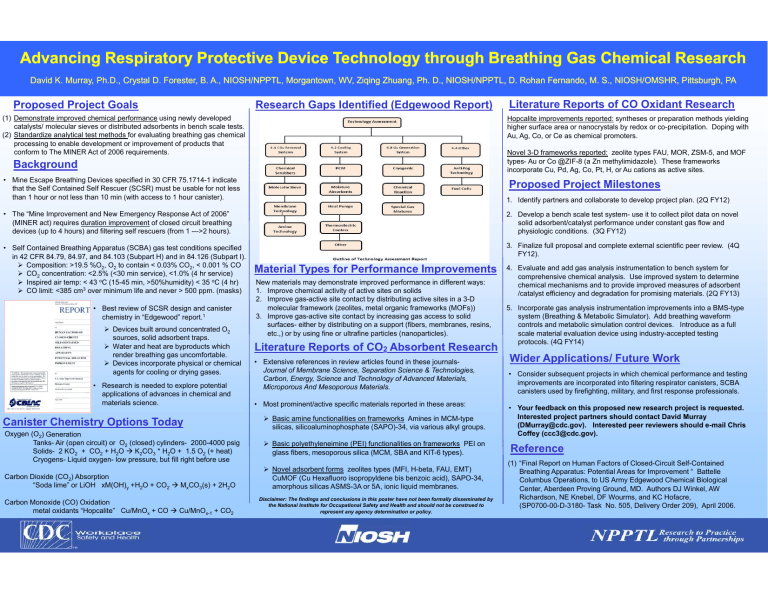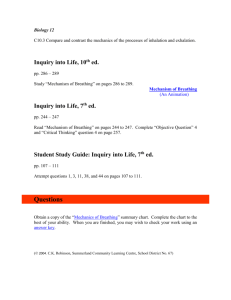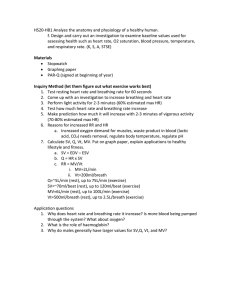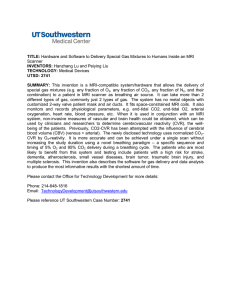Advancing Respiratory Protective Device Technology through Breathing Gas Chemical Research

David K. Murray, Ph.D., Crystal D. Forester, B. A., N IOSH/NPPTL, Morgantown, WV, Ziqing Zhuang, Ph. D., N IOSH/NPPTL, D. Rohan Fernando, M. S., NIOSH/OMSHR, Pittsburgh, PA
Proposed Project Goals
(1) Demonstrate improved chemical performance using newly developed catalysts/ molecular sieves or distributed adsorbents in bench scale tests.
(2) Standardize analytical test methods for evaluating breathing gas chemical processing to enable development or improvement of products that conform to The MINER Act of 2006 requirements.
Background
• Mine Escape Breathing Devices specified in 30 CFR 75.1714-1 indicate that the Self Contained Self Rescuer (SCSR) must be usable for not less than 1 hour or not less than 10 min (with access to 1 hour canister).
Research Gaps Identified (Edgewood Report) Literature Reports of CO Oxidant Research
Hopcalite improvements reported: syntheses or preparation methods yielding higher surface area or nanocrystals by redox or co-precipitation. Doping with
Au, Ag, Co, or Ce as chemical promoters.
Novel 3-D frameworks reported: zeolite types FAU, MOR, ZSM-5, and MOF types- Au or Co @ZIF-8 (a Zn methylimidazole). These frameworks incorporate Cu, Pd, Ag, Co, Pt, H, or Au cations as active sites.
Proposed Project Milestones
1. Identify partners and collaborate to develop project plan. (2Q FY12)
2. Develop a bench scale test system- use it to collect pilot data on novel solid adsorbent/catalyst performance under constant gas flow and physiologic conditions. (3Q FY12)
• The “Mine Improvement and New Emergency Response Act of 2006”
(MINER act) requires duration improvement of closed circuit breathing devices (up to 4 hours) and filtering self rescuers (from 1 --->2 hours).
• Self Contained Breathing Apparatus (SCBA) gas test conditions specified in 42 CFR 84.79, 84.97, and 84.103 (Subpart H) and in 84.126 (Subpart I).
Composition: >19.5 %O
2
CO
2
, O
2 to contain < 0.03% CO
2
, < 0.001 % CO concentration: <2.5% (<30 min service), <1.0% (4 hr service)
Inspired air temp: < 43 o C (15-45 min, >50%humidity) < 35 o C (4 hr)
CO limit: <385 cm 3 over minimum life and never > 500 ppm. (masks)
• Best review of SCSR design and canister chemistry in “Edgewood” report.
1
Devices built around concentrated O
2 sources, solid adsorbent traps.
Water and heat are byproducts which render breathing gas uncomfortable.
Devices incorporate physical or chemical agents for cooling or drying gases.
• Research is needed to explore potential applications of advances in chemical and materials science.
Canister Chemistry Options Today
Oxygen (O
2
) Generation
Tanks- Air (open circuit) or O
2
Solids- 2 KO
2
+ CO
2
+ H
2
O
(closed) cylinders- 2000-4000 psig
K
2
CO
3
* H
2
O + 1.5 O
2
(+ heat)
Cryogens- Liquid oxygen- low pressure, but fill right before use
Carbon Dioxide (CO
2
) Absorption
“Soda lime” or LiOH xM(OH) y
+H
2
O + CO
2
M x
CO
3
(s) + 2H
2
O
Carbon Monoxide (CO) Oxidation metal oxidants “Hopcalite” Cu/MnO x
+ CO Cu/MnO x-1
+ CO
2
3. Finalize full proposal and complete external scientific peer review. (4Q
FY12).
Material Types for Performance Improvements
New materials may demonstrate improved performance in different ways:
1. Improve chemical activity of active sites on solids
2. Improve gas-active site contact by distributing active sites in a 3-D molecular framework (zeolites, metal organic frameworks (MOFs))
3. Improve gas-active site contact by increasing gas access to solid surfaces- either by distributing on a support (fibers, membranes, resins, etc.,) or by using fine or ultrafine particles (nanoparticles).
Literature Reports of CO
2
Absorbent Research
4. Evaluate and add gas analysis instrumentation to bench system for comprehensive chemical analysis. Use improved system to determine chemical mechanisms and to provide improved measures of adsorbent
/catalyst efficiency and degradation for promising materials. (2Q FY13)
5. Incorporate gas analysis instrumentation improvements into a BMS-type system (Breathing & Metabolic Simulator). Add breathing waveform controls and metabolic simulation control devices. Introduce as a full scale material evaluation device using industry-accepted testing protocols. (4Q FY14)
Wider Applications/ Future Work
• Extensive references in review articles found in these journals-
Journal of Membrane Science, Separation Science & Technologies,
Carbon, Energy, Science and Technology of Advanced Materials,
Microporous And Mesoporous Materials.
• Consider subsequent projects in which chemical performance and testing improvements are incorporated into filtering respirator canisters, SCBA canisters used by firefighting, military, and first response professionals.
• Most prominent/active specific materials reported in these areas:
Basic amine functionalities on frameworks Amines in MCM-type silicas, silicoaluminophosphate (SAPO)-34, via various alkyl groups.
• Your feedback on this proposed new research project is requested.
Interested project partners should contact David Murray
(DMurray@cdc.gov). Interested peer reviewers should e-mail Chris
Coffey (ccc3@cdc.gov).
Basic polyethyleneimine (PEI) functionalities on frameworks PEI on glass fibers, mesoporous silica (MCM, SBA and KIT-6 types).
Novel adsorbent forms zeolites types (MFI, H-beta, FAU, EMT)
CuMOF (Cu Hexafluoro isopropyldene bis benzoic acid), SAPO-34, amorphous silicas ASMS-3A or 5A, ionic liquid membranes.
Disclaimer: The findings and conclusions in this poster have not been formally disseminated by the National Institute for Occupational Safety and Health and should not be construed to represent any agency determination or policy.
Reference
(1) “Final Report on Human Factors of Closed-Circuit Self-Contained
Breathing Apparatus: Potential Areas for Improvement “ Battelle
Columbus Operations, to US Army Edgewood Chemical Biological
Center, Aberdeen Proving Ground, MD. Authors DJ Winkel, AW
Richardson, NE Knebel, DF Wourms, and KC Hofacre,
(SP0700-00-D-3180- Task No. 505, Delivery Order 209), April 2006.







